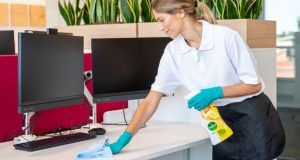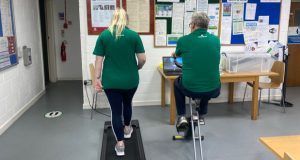
By Dave Rudge, REACT Specialist Cleaning
With an increase in hospital cleanliness, it would be the assumption that there would be a decrease in the spread of hospital-acquired infections (HAIs), however, there has been little evidence to suggest such a link and it is because of this that the UK has focused on single measure strategies to tackle the spread of HAIs rather than a more comprehensive approach.
Healthcare-acquired infections can affect any person in any age group and can often awaken underlying health conditions, delay recovery and have a prolonged effect on their quality of life. They are also just as likely to infect healthy people. A survey by NHS England in 2011 on healthcare-acquired infections and antimicrobial use revealed that around 30,0000 patients a year contracted a healthcare-acquired infection while being in the care of the NHS. This forced trusts to be more aware of how infections spread, resulting in an increase in surface disinfection and ward cleanliness.
The COVID-19 pandemic swept across the globe over the past year and a half, overwhelming hospitals and impacting lives across the world as we were forced into unseen circumstances. However, it raised the issue of unhygienic practises and highlighted the need for us to take more responsibility in controlling the spread of HAIs as research has revealed that 11% of patients with COVID-19 in 314 hospitals became infected after hospital admission.
HAIs have been a common feature of previous coronavirus outbreaks and without sufficient infection control in hospitals, we can predict that they will play an important role in amplifying transmission in the future.
COVID-19 and healthcare-acquired infections
Whilst transmission of the virus in hospital settings is commonly acknowledged, the precise time of infection is rarely known making it difficult to establish whether an infection is actually healthcare-acquired. However, population surveys have shown that patient-facing health and social care workers made up around 10% of all COVID-19 infections between 26th April and 7th June 2020 in England with an extra 1% of infections during this period being from inpatients in hospitals.
A DELVE report reveals that during the course of the pandemic there hasn’t been sufficient data collected to better understand the sources and risks of hospital-acquired transmissions to allow for effective infection control. Therefore, there is evidently a gap in our knowledge and better evidence is needed on the key transmission routes, who the virus affects, and how it is then transmitted onwards in order to minimise the risk of hospital transmission.
Epidemiological evidence of healthcare-acquired infections
There is compelling evidence to suggest that healthcare-acquired COVID-19 infections has been a result of poor prevention control in countries such as France, Germany and South Africa. Failure to use the appropriate personal protective equipment (PPE) such as face masks, gowns, eye protection and gloves, as well as poor hand hygiene, inadequate disinfection of surfaces and maintenance of ventilation have been just some of the causes of poor prevention.
In one South African hospital, 80 healthcare workers and 39 patients tested positive for a healthcare-acquired infection which was attributed to the incorrect management of staff and patients, insufficient hand washing, and delayed identification of positive patients. There is evidence to suggest the way in which we manage staff and patients in an epidemic can have a critical impact on the further spread of the HAIs. This can be seen when we explore the differentiating experiences in the Netherlands and the UK from previous outbreaks.
The Netherlands have been successful in controlling the spread of HAIs in hospital settings in the past as they quickly adopted a Search-and-Destroy (SAD) policy. This approach centred around isolating positive patients and staff until cultures proved negative. The Dutch authorities worked effectively to contain and destroy these diseases when they were first detected. Staff were also told to go home and remain there if they had been in close contact with a positive patient and until they were proven negative. Robust isolation strategies like this can be complicated and time-consuming but they were largely successful in keeping bacteremia levels very low in comparison to the UK where levels reached up to 50%.
The UK were skeptical about adopting the same approach due to fears of clinical disruption, thus the emphasis was placed on single-measure strategies such as hand hygiene – seen through the Cleanyourhands campaign. As a result, there was a year-on-year increase of HAI-related deaths and it was not until 2007 when the UK introduced isolation strategies, deep cleans and improved testing of staff and patients that this began to fall.
The above highlights the need for an adequate and comprehensive review of ward cleanliness is imperative in order to minimise the risk of hospital transmission of these types of infections.
The best ways to ‘break the chain’ of transmission in healthcare settings
Specialist infection control technologies, such as ultraviolet (UV-C) light and hydrogen peroxide vapour (HPV), can play a central role in stopping the spread of infection.
UV-C is a trusted method of disinfection and has been used in hospital settings for around 100 years. It uses short-wavelength light to disrupt the DNA of inactive microorganisms, which then destroys them making them unable to carry out cellular functions which cause the spread of HAIs. This process is often used by specialist cleaning companies when conducting a deep cleaning process as it is an effective method when trying to reach small and enclosed areas, and has been successful in destroying previous coronaviruses.
HPV is a liquid chemical compound consisting of hydrogen and oxygen atoms. It is a powerful oxidising agent that naturally decomposes into water and oxygen. It is particularly successful in enclosed areas where it releases small droplets of hydrogen peroxide to kill bacteria. The combination of vapour dispersal technology as well as powerful circulation makes it an effective method for sterilising and disinfecting surfaces contaminated with HAIs.
Whilst both methods are easy and safe to use, UV-C is a more popular process as it is more cost-effective, quick and easy to conduct, thus minimising clinical disruption. It is also a method that has been used for a long period of time, therefore trusts are more inclined to continue with this process for ease. However, while UV-C is timely and best suited to busy trusts, HPV is arguably more effective as the process is thorough. Therefore, if you have a ward prone to HAI breakouts, HPV decontamination will ultimately create a safer environment for patients and healthcare workers.
What’s next?
The COVID-19 outbreak has put pressure on healthcare settings to think more holistically about their approach towards ward cleanliness. However, despite ward cleanliness being logically associated with the reduced spread of HAIs, there is little evidence to prove this. It is because of this, coupled with the financial constraints trusts are faced with, that the UK has often relied on single-measure strategies and has considered deep cleans or more thorough cleaning processes of less importance.More data must be collected so that healthcare authorities can be led by the results to produce evidence-based policies rather than loose guidance for trusts. In the meantime, UK trusts should continue to have a comprehensive strategy towards the cleaning and maintenance of healthcare settings including patient screening, cohorting of patients and staff, improved use of technologies and regular deep cleans as well as hand hygiene. This approach will lead to an overall decrease in the spread of HAIs and provide a safer environment for both staff and patients.





